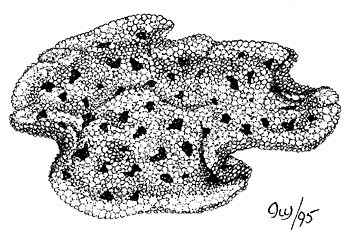Placozoa
- Trichoplax adhaerens
- Treptoplax reptans
References
Birstein, V. J. 1989. On the Karyotype of Trichoplax sp. (Placozoa). Biologisches Zentralblatt 108:63-67.
Buchholz, K. and A. Ruthmann. 1995. The mesenchyme-like layer of the fiber cells of Trichoplax adhaerens (Placozoa), a syncytium. Zeitschrift für Naturforschung Section C 50:282-285.
Dellaporta, S. L., A. Xu, S. Sagasser, W. Jakob, M. A. Moreno, L. W. Buss, and B. Schierwater. 2006. Mitochondrial genome of Trichoplax adhaerens supports placozoa as the basal lower metazoan phylum. Proceedings of the National Academy of Sciences (U.S.A.) 103(23):8751-8756.
Ender, A. and B. Schierwater. 2003. Placozoa are not derived cnidarians: Evidence from molecular morphology. Molecular Biology and Evolution 20(1):130-134.
Grell, K. G. and A. Ruthmann. 1991. Placozoa. Pages 13-28 in Microscopic Anatomy of Invertebrates, Vol. 2. Placozoa, Porifera, Cnidaria, and Ctenophora. F. W. Harrison (ed.) New York: Wiley-Liss.
Miller, D. J. and E. E. Ball. 2005. Animal evolution: the enigmatic phylum Placozoa revisited. Current Biology 15(1):26-28.
Ruthmann, A., G. Behrendt, and R. Wahl. 1986. The ventral epithelium of Trichoplax adhaerens (Placozoa) - cytoskeletal structures, cell contacts and endocytosis. Zoomorphology 106:115-122.
Schierwater. B. 2005. My favorite animal, Trichoplax adhaerens. BioEssays 27:1294-1302.
Schuchert, P. 1993. Trichoplax adhaerens (Phylum Placozoa) has cells that react with antibodies against the neuropeptide Rfamide. Acta Zoologica 74:115-117.
Syed, T. and B. Schierwater. 2002. The evolution of the Placozoa: a new morphological model. Senckenbergiana lethaea 82:259–270.
Thiemann, M. and A. Ruthmann. 1988. Trichoplax adhaerens Schulze, F. E. (Placozoa) - The formation of swarmers. Zeitschrift für Naturforschung Section C 43:955-957.
Thiemann, M. and A. Ruthmann. 1989. Microfilaments and microtubules in isolated fiber cells of Trichoplax adhaerens (Placozoa). Zoomorphology 109:89-96.
Thiemann, M. and A. Ruthmann. 1990. Spherical forms of Trichoplax adhaerens (Placozoa). Zoomorphology 110:37-45.
Thiemann, M. and A. Ruthmann. 1991. Alternative modes of sexual reproduction in Trichoplax adhaerens (Placozoa). Zoomorphology 110:165-174.
Ueda, T., S. Koya, and Y. K. Maruyama. 1999. Dynamic patterns in the locomotion and feeding behaviors by the placozoan Trichoplax adhaerence. Biosystems 54:65-70.
Information on the Internet
- Introduction to Placozoa. UCMP Berkeley.
- The Trichoplax Genome Project at the Yale Peabody Museum
- A Weird Wee Beastie: Trichoplax adhaerens. Micscape Magazine article on Placozoa.
- Pharyngula on Trichoplax:
Title Illustrations
| Scientific Name | Placozoa |
|---|---|
| Comments | Diagram of the external features of a placazoan. |
| Creator | Ivy Livingstone |
| Copyright |
© 1995 BIODIDAC

|
About This Page
Page copyright © 2002
- First online 14 August 2006
Citing this page:
Tree of Life Web Project. 2006. Placozoa. Version 14 August 2006 (temporary). http://tolweb.org/Placozoa/2463/2006.08.14 in The Tree of Life Web Project, http://tolweb.org









 Go to quick links
Go to quick search
Go to navigation for this section of the ToL site
Go to detailed links for the ToL site
Go to quick links
Go to quick search
Go to navigation for this section of the ToL site
Go to detailed links for the ToL site